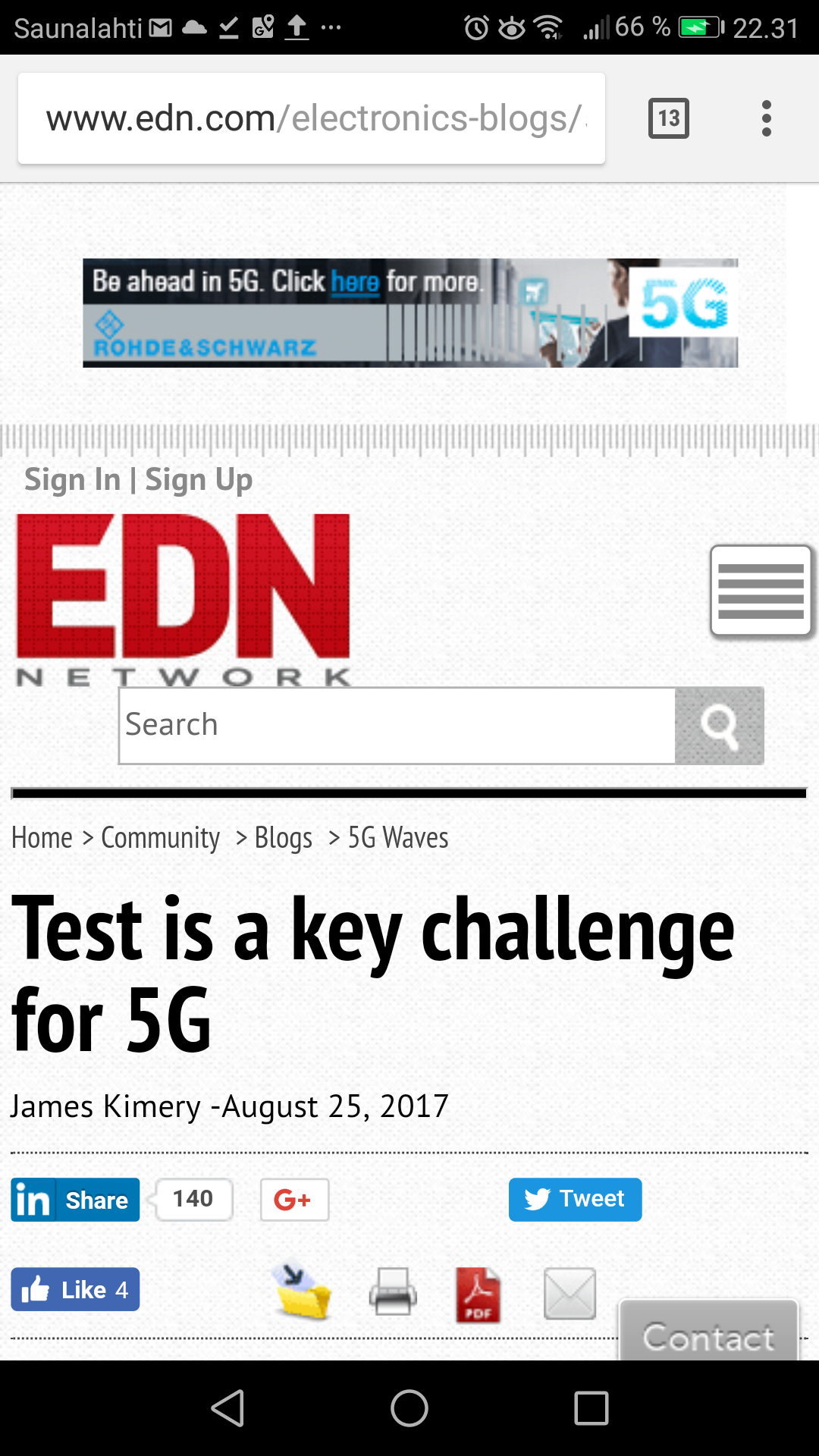The most recent 3GPP (Third Generation Partnership Project) Plenary meeting in West Palm Beach, Florida confirmed that the industry continues to make excellent progress for meeting the goal of having the 5G New Radio (5G NR) physical layer defined by December 2017. But there is still a long road ahead.

4 Comments
Tomi Engdahl says:
Digitizer/DSP analyzes RF and serial signals
http://www.edn.com/electronics-products/electronic-product-reviews/other/4458794/Digitizer-DSP-analyzes-RF-and-serial-signals
With so many RF/wireless and high-speed serial connections in development today, high-speed digitizers with analysis capabilities are essential tools. Guzik has introduced the ADP7000 series of digitizers that add a 10-bit analog front end to the company’s DP7000 signal-processing module. The combination brings high-speed data acquisition and signal analysis to automated systems using the AXIe format.
The ADP 7000 series consists of two four-channel models with 50 Ω input impedance that differ in sample rate and bandwidth
You can use these digitizers for capturing and analyzing wireless signals in the sub-10 GHz range, which covers everything through the H-band (today’s cellular networks operate below 6 GHz). Future 5G networks will likely start at frequencies below 6 GHz so the ADP7000 can analyze those signals as they come online.Once 5G moves into mmWave frequencies, you can combine the ADP7000 with a downconverter to digitize IF signals.
Simply digitizing signals isn’t enough. That’s where Guzik’s DP7000 signal-processing module comes in. Its four Intel ARRIA 10 FPGAs provide on-module data analysis. The modules are available with numerous signal-processing firmware options. These include channel equalization, filtering, multi-segment time-tagged acquisition, real-time digital down conversion (DDC), Fast Fourier Transform (FFT), Discrete Fourier Transform (DFT), waveform min/max, and real-time waveform averaging for smoothing noisy signals.
In addition to using on-module signal processing, you can use Keysight’s 89600 Vector Signal Analyzer (VSA) software and 81199A Wideband Waveform Analyzer Studio.
Tomi Engdahl says:
ZTE kickstarts NSA 5G NR tests: What is it and why should we care?
http://www.edn.com/electronics-blogs/5g-standards-watch/4458688/ZTE-kickstarts-NSA-5G-NR-tests–What-is-it-and-why-should-we-care-
5G New Radio (5G-NR) was a hot topic for discussion at Mobile World Congress in February; it got formal recognition as RP-170741 by the 3GPP at its meeting in Dubrovnik in March; and on July 10, it got real, with ZTE and China Unicom collaborating on tests in the 3.5-GHz band.
To understand what this means, let’s unpack all that, starting with a quick description of 5G NR and an introduction to NSA 5G NR, the version that got approved at Dubrovnik.
5G NR derived from work led by Qualcomm to develop a unified air interface and network to address the need for enhanced mobile broadband with gigabit-per-second speeds; mission-critical automotive, medical and industrial services; and the “massive” Internet of things (IoT) now unfolding
The new radio interface was designed to address these applications, while also incorporating a flexible approach to spectrum usage and overall lower latency and cost per bit.
Building upon LTE, the interface and modulation scheme of choice for 5G NR is an optimized version of multiple-access OFDM with dynamic, low-latency TDD and FDD, making it both backward compatible with current infrastructure, and forward compatible with where LTE is headed. It also emphasizes the use of massive MIMO, operation both below and above 6 GHz, beamforming, and low-density parity check (LDPC).
Tomi Engdahl says:
5G: How Do You Test for a Standard that Doesn’t Even Exist?
http://www.electronicdesign.com/test-measurement/5g-how-do-you-test-standard-doesn-t-even-exist
5G NR is ascending rapidly as the 5G technology of choice, but it turns out lots can be done to get ready as it goes through the formal 3GPP channels.
It’s almost here, sort of. The Qualcomm-led 5G New Radio initiative is accelerating through the 3GPP wormhole and should start emerging as a formal specification in two stages in 2018. But how do we test to it in the meantime? Well, I asked the experts at Keysight.
This isn’t a new problem, of course. Designers and developers have been conducting tests on emerging standards for decades: Make an educated guess at what the standard will comprise based on the target market requirements—and which companies are pushing the standard. Odds are high that the key technologies being advocated by the main pushers will be part of the standard. For better or for worse.
However, 5G is different in many ways. Not least of which is that it’s huge. Ginormous, in fact (Fig. 1). It affects everything, from applications like small sensor connections for the IoT to autonomous vehicles, and technologies that include massive MIMO to software defined networking (SDN) and network function virtualization (NFV).
Tomi Engdahl says:
Home> Test-and-measurement Design Center > How To Article
5G front haul, backhaul architectures present wireline test challenges
http://www.edn.com/design/test-and-measurement/4458788/5G-front-haul–backhaul-architectures-present-wireline-test-challenges?utm_content=buffer30075&utm_medium=social&utm_source=twitter.com&utm_campaign=buffer
Wireless front-haul and backhaul infrastructures have been undergoing an evolution for the past few years. Base stations now employ Centralized-Radio Access Networks (C-RAN), Common Public Radio Interface (CPRI) and fiber to meet the high bandwidth demands of today’s consumer. That will only continue as the industry prepares for 5G. To accommodate the network changes, test instruments are evolving to address new standards and emerging designs, both for wireless and wireline links.
5G will not be built solely from wireless standards. Its foundation is 3GPP-defined radio, but to deliver the high bandwidth services expected, wireline links will be important. To that end, the International Telecommunications Union’s (ITU) wireline division recently published recommendations for data networking to support 5G. Another indicator of the wireless/wireline convergence is that more mobile operators are joining the Central Office Re-architected as a Datacenter (CORD), an open-source initiative originally started by wireline leaders.